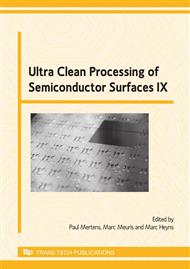p.23
p.27
p.31
p.35
p.39
p.43
p.47
p.51
p.55
High Velocity Aerosol Cleaning with Organic Solvents: Particle Removal and Substrate Damage
Abstract:
High velocity aerosol cleaning using ultrapure water or dilute aqueous solutions (e.g. dilute ammonia) is common in semiconductor IC fabrication [1]. This process combines droplet impact forces with continuous liquid flow for improved cleaning efficiency of sub-100nm particles. As with any physically enhanced cleaning process, improved particle removal can be accompanied by increased substrate damage, especially to smaller (<80nm) features [2]. Solvents such as N-methylpyrrolidone (NMP) and tetrahydrofurfuryl alcohol (THFA) are used for resist strip applications [3]. It is possible, and sometimes useful, to deliver these solvents through the same spray nozzle normally used for aqueous spray cleaning. In this presentation we explore the particle removal and substrate damage performance of 2-ethoxyethanol (EGEE), NMP and THFA as used in a conventional aerosol spray cleaning system
Info:
Periodical:
Pages:
39-42
Citation:
Online since:
January 2009
Keywords:
Price:
Сopyright:
© 2009 Trans Tech Publications Ltd. All Rights Reserved
Share:
Citation:


